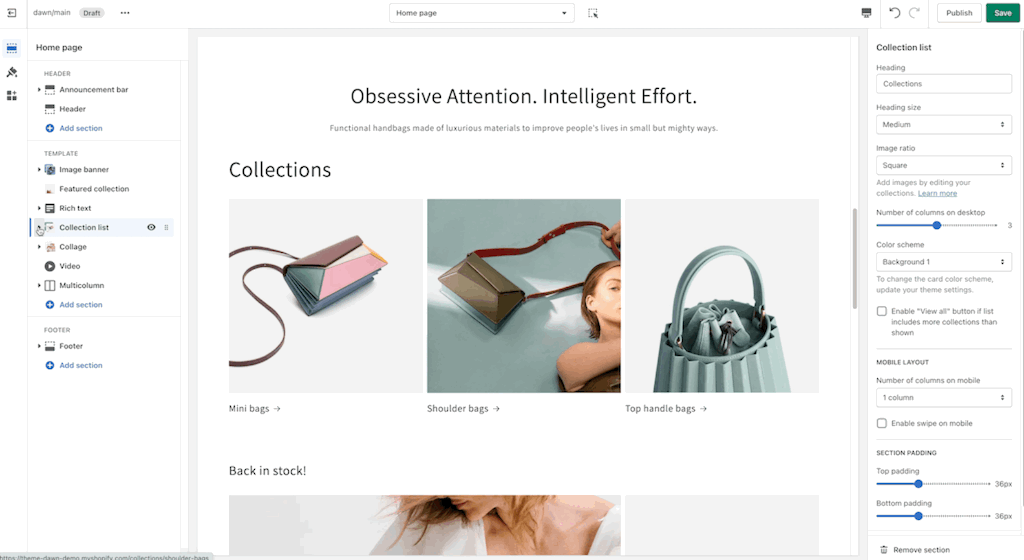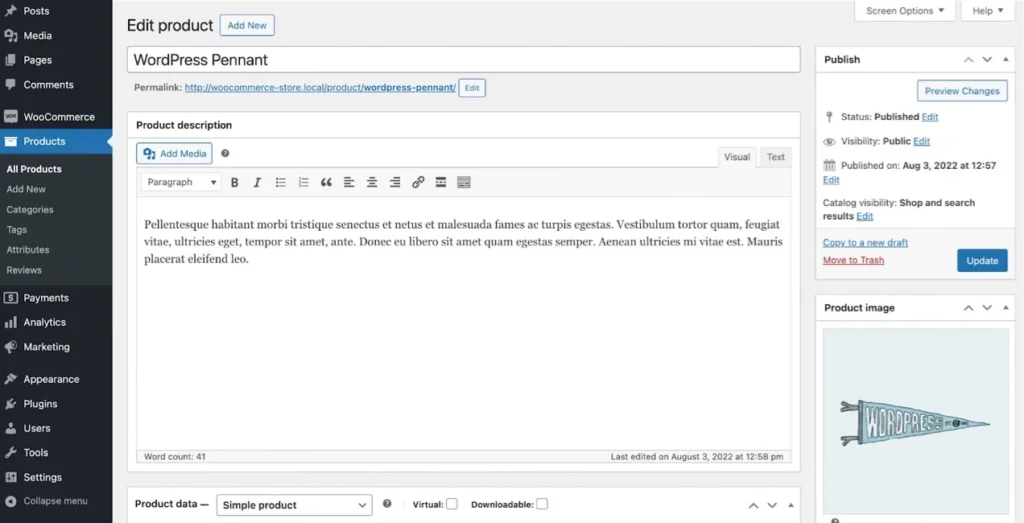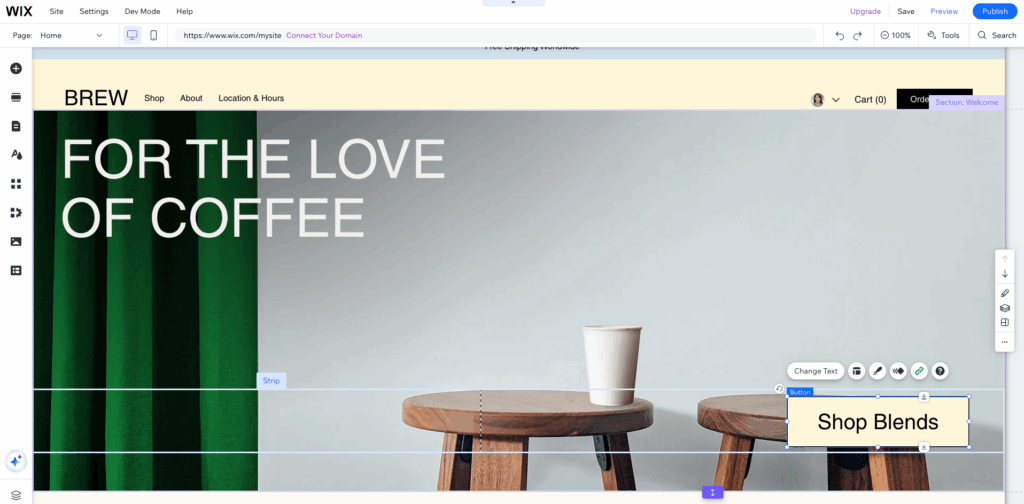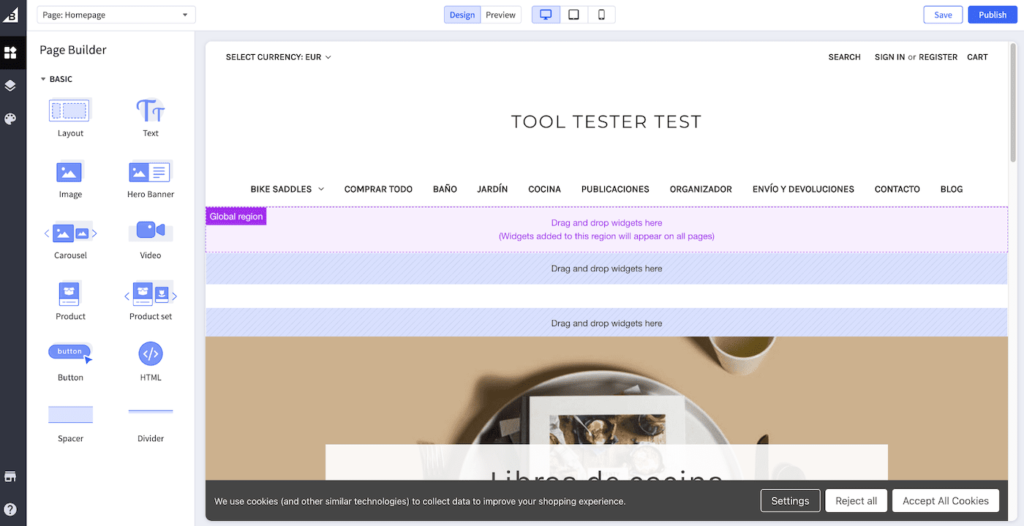In the fast-paced digital landscape of 2025, building a robust and compelling eCommerce website is more critical than ever for businesses aiming to thrive online. With technological advancements continuing to shape consumer behaviors and expectations, selecting the right platform can make all the difference in creating a seamless shopping experience. This guide delves into the five best eCommerce website-building platforms available today, examining their pros, cons, and standout features. Whether you’re a small business or a large enterprise, understanding these platforms’ capabilities will equip you with the knowledge to make an informed decision. Let’s explore the cutting-edge tools that are revolutionizing the online marketplace and helping businesses succeed in the digital age.
What is an ecommerce platform?
An e-commerce platform is a comprehensive software solution that allows businesses to conduct transactions online. It provides the necessary tools for businesses to create and manage their online stores, including features for product listing, payment processing, shopping cart management, and customer service. These platforms often come with a variety of integrations, allowing for enhanced functionality, such as marketing automation, inventory management, and product shipping.
In 2025, e-commerce platforms have evolved to offer even more sophisticated features, such as AI-driven personalization, advanced analytics, and support for emerging technologies like augmented reality (AR) and virtual reality (VR). The best ecommerce platforms also prioritize user experience, both for merchants and customers, ensuring that building and navigating the store is as intuitive and seamless as possible.
Furthermore, e-commerce platforms can be categorized into different types depending on the needs of the business. Some are open-source, offering extensive customization options at the cost of requiring more technical expertise, while others are fully hosted, providing a more user-friendly experience with less need for in-depth technical knowledge but potentially less flexibility. These platforms can cater to specific niches, from enterprises needing complex, large-scale operations to startups looking for affordability and simplicity.
Ultimately, an ecommerce platform acts as the backbone of your online business, supporting every transaction
Things to Consider when Choosing an Ecommerce Platform
and interaction with your customers. Therefore, choosing the right platform means evaluating a variety of key factors to ensure it aligns with your business goals and can grow alongside your business. Here are some important considerations when selecting an ecommerce platform:
1. User-Friendliness
The ease of use is perhaps one of the most crucial factors to consider. A platform with an intuitive interface allows you to focus more on your business operations rather than getting bogged down by technical difficulties. Look for platforms that offer drag-and-drop editing, clear navigation, and easy store management features.
2. Payment Options
Another significant aspect to evaluate is the variety of payment options available. A good eCommerce platform should support multiple payment gateways, including popular services like PayPal, Stripe, Apple Pay, Google Pay, and traditional credit/debit card processing. The more payment options you offer, the easier it is for customers from diverse regions and with different preferences to make a purchase.
3. Shipping Options
The availability of localized payment methods is also important, especially if you are targeting international markets. This includes country-specific payment providers or local banking systems that some regions may favor. Having multiple payment options can significantly reduce cart abandonment rates and enhance the checkout process, making it more convenient for your customers.
4. Scalability
As your business grows, your e-commerce platform should be able to accommodate increased traffic, large product catalogs, and more extensive orders without affecting performance. Scalability is critical for ensuring that your platform can handle seasonal traffic spikes or long-term growth needs. Evaluate the platform’s ability to upgrade its infrastructure or support additional functionality and integrations as your business expands.
5. Pricing
Pricing is a pivotal factor when selecting an eCommerce platform, as it directly impacts your budget and profits. Consider the cost of subscriptions, transaction fees, and any additional charges for premium features or plugins. It’s essential to evaluate whether the platform offers a pricing structure that is flexible and transparent. Look for plans that align with your business size and model, providing room for growth without excessive cost hikes. Ensure that the value you receive in terms of features and support justifies the expenditure, allowing you to balance affordability with functionality.
6. Security
Security is paramount for any eCommerce platform, as it deals with sensitive customer data and financial transactions. In 2025, the best platforms prioritize top-tier security measures, including SSL certification, PCI-DSS compliance, and robust firewalls to protect against cyber threats. Additionally, they offer features such as two-factor authentication, data encryption, and regular security updates to safeguard your business against potential breaches. Ensuring that the platform provides a secure environment not only builds customer trust but also helps you comply with legal and industry standards, ultimately protecting your brand’s reputation and your customers’ information.
7. Integration Capabilities
Your eCommerce platform should seamlessly integrate with the tools and systems you already use—or plan to use—as your business grows. These can include inventory management software, accounting tools like QuickBooks or Xero, marketing platforms such as Mailchimp or Klaviyo, CRM systems, and even social media channels. A platform with robust APIs and a wide marketplace of third-party apps enables you to create a highly customized and efficient workflow. Strong integration capabilities not only improve operational efficiency but also enhance the customer experience by enabling features like personalized marketing, real-time inventory updates, and automated order processing.
5 Best Ecommerce Platforms To Use in 2025
Now that we’ve explored the key factors to consider when choosing an eCommerce platform, let’s look at the top options available in 2025. These platforms stand out for their performance, scalability, and ability to support businesses across various industries and sizes.
Shopify

Shopify is a Canadian eCommerce platform headquartered in Ottawa, Ontario, serving over 5.6 million active stores across more than 175 countries as of 2024 . In 2023, Shopify merchants collectively processed $235.9 billion in Gross Merchandise Volume (GMV), reinforcing its status as a top-tier eCommerce solution .
Shopify Key Features
- User-Friendly Interface: Shopify offers an intuitive dashboard, allowing users with minimal technical expertise to set up and manage their online stores efficiently .
- Extensive App Ecosystem: With over 10,000 apps available in the Shopify App Store, merchants can enhance their store’s functionality in areas like marketing, inventory management, and customer engagement.
- Multi-Channel Selling: Shopify enables sales across various platforms, including social media channels like Facebook and Instagram, as well as marketplaces like Amazon and eBay.
- Mobile Optimization: All Shopify themes are responsive, ensuring a seamless shopping experience across devices.
- 24/7 Customer Support: Merchants have access to round-the-clock support via live chat, email, and phone.
Shopify Pros and Cons
Pros
- Ease of Use: The platform’s user-friendly design simplifies the process of launching and managing an online store.
- Scalability: Shopify caters to businesses of all sizes, from startups to large enterprises, with plans like Shopify Plus designed for high-volume merchants.
- Robust App Integration: The vast app marketplace allows for extensive customization and functionality enhancements .
Cons
- Transaction Fees: Unless using Shopify Payments, merchants incur additional transaction fees ranging from 0.5% to 2%.
- Limited Free Themes: Shopify offers fewer than 15 free themes, with additional themes available for purchase.
- Customization Constraints: Advanced customizations may require knowledge of Shopify’s proprietary Liquid coding language, potentially necessitating developer assistance.
Shopify Pricing Plans
As of 2025, Shopify offers several pricing tiers to accommodate various business needs:
- Basic Shopify: $29/month – Suitable for new businesses, includes essential eCommerce features.
- Shopify: $79/month – Offers additional features like professional reports and international pricing.
- Advanced Shopify: $299/month – Includes advanced report building and third-party calculated shipping rates.
- Shopify Plus: Starting at $2,000/month – Designed for high-volume enterprises, offering advanced customization and dedicated support.
Each plan provides access to Shopify’s core features, with higher tiers offering more advanced capabilities to support growing businesses.
Overall, Shopify stands out as a powerful, user-friendly platform that simplifies online selling. With strong multichannel support and built-in scalability, it’s a smart choice for businesses that want a polished, ready-to-grow solution.
WooCommerce

WooCommerce is a free, open-source eCommerce plugin for WordPress that powers over 3.6 million online stores worldwide, making it one of the most widely used platforms globally . Its flexibility and deep integration with WordPress have made it a popular choice for businesses seeking customizable online selling solutions.
WooCommerce Key Features
- Seamless WordPress Integration: As a plugin for WordPress, WooCommerce allows users to leverage the content management capabilities of WordPress alongside robust eCommerce functionalities .
- Extensive Customization: With thousands of themes and plugins available, WooCommerce offers unparalleled customization options to tailor the online store to specific business needs .
- Flexible Product Management: WooCommerce supports various product types, including physical goods, digital products, subscriptions, and memberships, providing versatility for different business models .
- Diverse Payment Options: The platform supports over 140 region-specific payment gateways, including WooPayments, Stripe, PayPal, Square, and Amazon Pay, facilitating secure and convenient transactions .
- Scalable Shipping Solutions: WooCommerce offers flexible shipping options, including real-time calculations, flat rates, and local pickup, accommodating various logistical requirements .
- Robust Analytics and Reporting: Built-in analytics tools provide insights into sales performance, customer behavior, and inventory management, aiding in data-driven decision-making .
WooCommerce Pros and Cons
Pros
- Cost-Effective Entry: The core WooCommerce plugin is free, allowing businesses to start selling online with minimal upfront investment.
- High Customizability: The open-source nature of WooCommerce enables extensive customization to meet unique business requirements.
- Large Community Support: A vast community of developers and users contributes to a wealth of resources, tutorials, and extensions.
Cons
- Technical Complexity: Setting up and managing a WooCommerce store may require technical knowledge, particularly for advanced customizations.
- Maintenance Responsibility: Users are responsible for managing hosting, security, and updates, which can be resource-intensive.
- Potential for Additional Costs: While the core plugin is free, additional functionalities often require paid extensions or themes.
WooCommerce Pricing Plans
While WooCommerce itself is free, running a fully functional online store involves various costs:
- Hosting: Costs can range from $3.99 per month for basic shared hosting to $5,000 per month for dedicated enterprise solutions .
- Domain Registration: Typically around $15 per year, though premium domains can cost significantly more.
- Themes: Thousands of free themes are available, but premium themes range from $20 to $100 per year.
- Extensions and Plugins: Depending on the desired functionalities, costs can vary widely, with some essential plugins being free and others requiring annual subscriptions.
Overall, WooCommerce is a highly flexible option for those already using WordPress. It’s ideal for sellers who value customization and control, and are willing to manage more of the technical setup themselves.
Wix

Wix is a versatile website builder that has evolved into a robust eCommerce platform, catering to businesses of all sizes. As of 2024, Wix holds an 18.28% market share in the U.S. eCommerce platform sector, powering over 1.8 million online stores . Its user-friendly interface and comprehensive features make it a popular choice among entrepreneurs and small to medium-sized businesses.
Wix Key Features
- Drag-and-Drop Editor: Wix’s intuitive editor allows users to design their online store without any coding knowledge, offering a wide range of customizable templates.
- Mobile Optimization: All Wix websites are automatically optimized for mobile devices, ensuring a seamless shopping experience across all platforms.
- Integrated Payment Solutions: Wix supports various payment methods, including credit cards, PayPal, and Stripe, providing flexibility for both merchants and customers .
- Multichannel Selling: Merchants can expand their reach by selling on multiple platforms such as Facebook, Instagram, and Amazon directly through Wix .
- Advanced SEO Tools: Wix offers built-in SEO features to help improve your store’s visibility on search engines, including customizable meta tags and URL structures.
- Comprehensive App Market: With over 250 apps, Wix’s App Market allows users to enhance their store’s functionality, from marketing tools to inventory management.
Wix Pros and Cons
Pros
- User-Friendly Interface: Ideal for beginners, Wix’s platform is easy to navigate, allowing for quick store setup and management.
- Affordable Pricing: Wix offers competitive pricing plans suitable for various business sizes and budgets.
- All-in-One Solution: From website building to eCommerce functionalities, Wix provides a comprehensive package without the need for third-party integrations.
Cons
- Limited Scalability: While suitable for small to medium-sized businesses, larger enterprises might find Wix’s features limiting as they scale.
- Template Restrictions: Once a template is chosen, switching to a different one requires rebuilding the site, which can be time-consuming.
- App Dependence: Some advanced features require third-party apps, which might incur additional costs.
Wix Pricing Plans
Wix offers several pricing tiers to accommodate different business needs:
- Core Plan: Starting at $29/month, this plan includes essential eCommerce features suitable for small businesses.
- Business Plan: At $36/month, it offers additional storage and advanced analytics tools.Forbes
- Business Elite Plan: Priced at $159/month, this plan is designed for larger businesses requiring advanced features and priority support .
Each plan includes a free domain for one year, removal of Wix ads, and access to customer support. It’s important to note that while Wix provides a free plan, eCommerce functionalities are only available in the paid tiers.
In summary, Wix stands out as a user-friendly and affordable eCommerce platform, particularly suited for small to medium-sized businesses looking to establish an online presence without extensive technical expertise.
BigCommerce

BigCommerce is a leading SaaS (Software-as-a-Service) eCommerce platform designed to serve both small businesses and large enterprises. Known for its built-in features, headless commerce capabilities, and robust scalability, BigCommerce is a strong contender for businesses that need more advanced out-of-the-box tools than Shopify or Wix.
As of 2024, BigCommerce powers over 46,000 live websites globally (BuiltWith), and has increasingly gained traction among B2B and hybrid B2B/B2C retailers due to its powerful API and flexibility. It’s also ISO/IEC 27001:2013 certified, ensuring enterprise-grade security.
BigCommerce Key Features
- Built-In Advanced Features: Unlike other platforms that rely heavily on apps, BigCommerce includes advanced features like real-time shipping quotes, custom product filtering, and customer groups (e.g., wholesale/retail) natively.
- Multi-Channel Selling: Seamless integration with Amazon, eBay, Walmart Marketplace, Meta (Facebook/Instagram), and Google Shopping.
- Headless Commerce Ready: BigCommerce supports headless architecture out-of-the-box, making it ideal for brands looking to decouple their front-end using frameworks like Next.js or Nuxt.
- Flexible Product Options: Unlike Shopify’s variant limits, BigCommerce supports up to 600 variants per product and 250 option values, which is particularly useful for complex product catalogs.
- Staging Environments: Built-in sandboxing for enterprise users to test changes before going live.
BigCommerce Pros and Cons
Pros
- No transaction fees—even when using third-party payment gateways.
- Strong B2B features, including custom pricing lists and quote management.
- High performance and fast page load times across store types.
- Built-in SEO tools such as customizable URLs and AMP for product pages
Cons
- Slightly steeper learning curve compared to Shopify.
- App marketplace is smaller than Shopify’s.
- Some advanced features only available on higher-tier enterprise plans.
BigCommerce Pricing Plans
BigCommerce offers four main pricing plans tailored to different business needs:
- Standard ($39/month): Includes unlimited products, multi-channel selling, and real-time shipping quotes
- Plus ($105/month): Adds abandoned cart saver and customer segmentation
- Pro ($399/month): Offers Google customer reviews, product filtering, and third-party real-time shipping
- Enterprise (Custom pricing): Provides advanced B2B features, dedicated support, and custom SLAs
All plans include unlimited products, no transaction fees, and 24/7 support. Pricing may scale based on your store’s annual revenue.
BigCommerce is ideal for growing businesses and enterprises needing strong native features, B2B tools, and multi-channel selling without heavy reliance on third-party apps. It’s especially suited for merchants seeking customization and scalability in the mid-market and enterprise space.
Squarespace

Squarespace is a design-focused website builder that also offers integrated eCommerce functionality. Known for its beautiful templates, all-in-one approach, and ease of use, it’s particularly popular among creatives, small businesses, and entrepreneurs who prioritize visual branding and simplicity.
While Squarespace doesn’t dominate the pure eCommerce market like Shopify or WooCommerce, it powers over 5.2 million live websites globally (BuiltWith, 2024), and is especially strong among service-based businesses, artists, and content creators looking to sell products, subscriptions, or digital content online.
Squarespace Key Features
- Stunning, Award-Winning Templates: Industry-leading templates tailored for visual impact across industries like fashion, design, photography, and wellness.
- Built-In Commerce Tools: Support for selling physical products, digital downloads, subscriptions, and services all without third-party plugins.
- Booking & Scheduling: Built-in integration with Acuity Scheduling, making it easy to manage appointments and services.
- Marketing Automation: Email marketing, promotional pop-ups, and social media integration are all natively available.
- Blogging & SEO: Excellent blogging tools with integrated SEO controls, making it a good hybrid platform for content and commerce.
Squarespace Pros and Cons
Pros
- Elegant, mobile-responsive designs out of the box.
- No need for separate hosting or app installations.
- Perfect for content-driven businesses (artists, writers, service providers).
- Integrated tools like analytics, email campaigns, and appointment scheduling.
Cons
- Limited extensibility compared to platforms like WooCommerce or Shopify.
- Fewer payment gateways (only Stripe, PayPal, Afterpay).
- No app marketplace—advanced features may require workarounds or external tools.
Squarespace Pricing Plans
Squarespace offers a streamlined platform for selling products online, with all plans including hosting, templates, and SSL. Here are their e-commerce-focused plans, priced for monthly billing:
- Business ($36/month): This plan includes basic commerce features but comes with a 3% transaction fee on sales. It’s a good starting point if you’re just testing the waters with online selling.
- Commerce Basic ($40/month): Stepping up, this plan removes all Squarespace transaction fees and adds essential e-commerce tools like customer accounts and merchandising features. It’s ideal for growing online stores.
- Commerce Advanced ($72/month): Designed for larger online businesses, this plan builds on Commerce Basic by adding powerful features such as abandoned cart recovery, subscription selling, and advanced shipping options.
All Squarespace plans include a free domain for the first year, 24/7 customer support, and integrated analytics. Squarespace is an excellent choice for entrepreneurs and creatives who value beautiful design, simplicity, and an all-in-one platform. While it might not be the best fit for very complex or large-scale operations, it provides a highly effective solution for stylishly showcasing and selling products.
Final Thoughts
Choosing the right eCommerce platform is one of the most important decisions you’ll make as an online business owner. As we’ve seen, each platform whether it’s Shopify, WooCommerce, Wix, BigCommerce, or Squarespace caters to different business needs, levels of technical expertise, and growth expectations.
- If you’re looking for an all-in-one, scalable solution with unmatched market dominance, Shopify is the top contender.
- For those already invested in WordPress or seeking extreme flexibility and control, WooCommerce stands out.
- Wix offers a simple, visual approach that works well for beginners and smaller storefronts.
- BigCommerce shines when you need enterprise-level capabilities with advanced commerce features.
- And Squarespace remains a favorite for creatives and service providers who want elegant design and ease without sacrificing functionality.
Ultimately, the best eCommerce platform is the one that aligns with your business goals, technical comfort, and customer experience priorities. Take time to assess your needs today and your vision for tomorrow so your platform can scale with you, not hold you back.
Whether you’re launching your first store or migrating from another solution, make your choice based on thoughtful criteria not just trends. Your platform is more than just a tool it’s the foundation of your online business.




